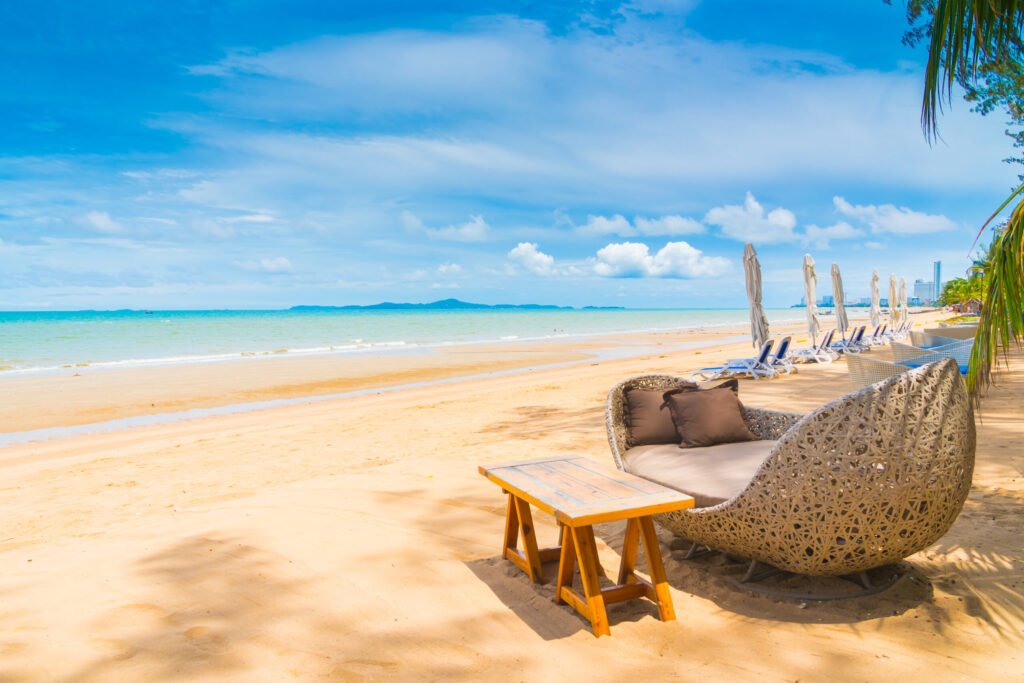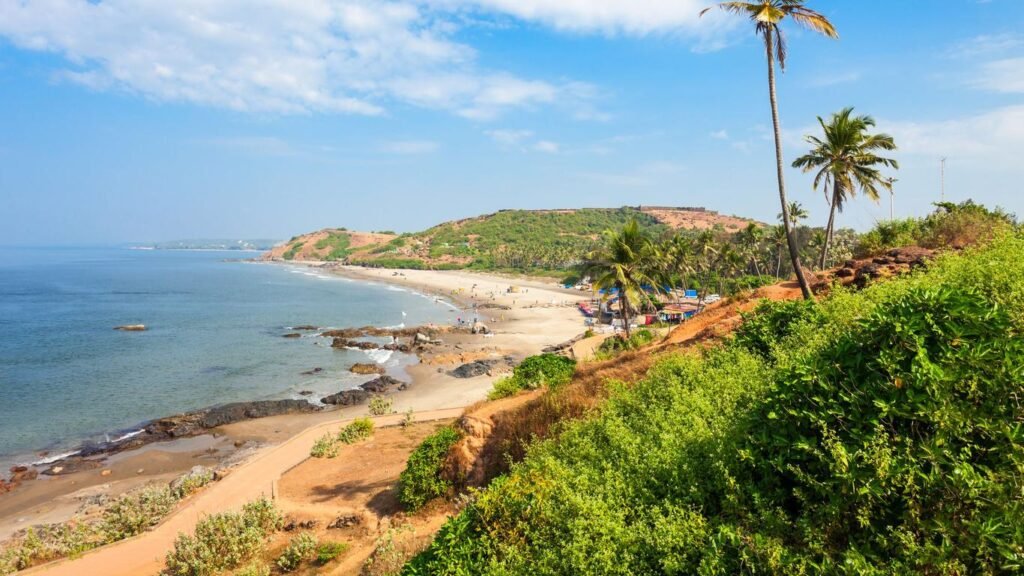Anjuna Beach in Goa stands as one of India’s most iconic beach destinations, renowned for its alternative spirit, natural beauty, rich history, vibrant nightlife, and status as a hub for both adventure and cultural experiences.
Anjuna Beach is located along the northern coastline of Goa, in the Bardez taluka, about 18 kilometers from the state capital, Panaji. Famed as the birthplace of Goa’s legendary hippie movement, Anjuna offers a distinct blend of free-spirited energy, scenic beauty, and vibrant nightlife that draws travelers from across the globe. Its landscape features golden sands, striking black rock outcrops, and lush coconut groves stretching alongside the blue Arabian Sea.
Location and How to Reach Anjuna Beach
Anjuna Beach lies to the north of Baga and Calangute beaches, with the nearby town of Mapusa acting as the principal gateway. It’s conveniently accessible via several transport options:
- By Air: The nearest airports are Goa Dabolim International Airport (43 km) and Manohar International Airport (28 km). Both offer prepaid taxis and car rental services directly to Anjuna.
- By Train: Thivim Railway Station (15 km away) is the closest rail link. From Thivim, take a bus or taxi to Mapusa, then a local bus or taxi to Anjuna.
- By Road: Buses connect Panaji, Mapusa, and neighboring towns to Anjuna. The drive from Panaji or Mapusa to Anjuna is scenic and takes around 30-45 minutes.
- By Own Vehicle: Anjuna is easily accessible for self-drivers through Goa’s well-maintained road network, especially via NH66.
Key Details:
History of Anjuna Beach
Early Beginnings
Anjuna’s roots trace back to a tiny fishing hamlet inhabited by Konkani-speaking locals, with traditional occupations such as fishing and agriculture forming the economic backbone. Its serene ambiance, coconut plantations, and laterite cliffs made it a peaceful, out-of-the-way village on the Goan coastline until the 1960s.
Hippie Movement & Cultural Revolution
The 1960s brought an irreversible transformation as Western travelers arrived in Goa, inspired by the global hippie movement. Anjuna’s tranquil setting, welcoming community, and promise of creative and spiritual freedom drew these pioneers, turning the beach into a hotbed of alternative lifestyles and artistic expression.
This era saw the beginning of trance music parties, full-moon gatherings, and psychedelic rock events, laying the foundation for the global Goa trance scene. The legendary Wednesday Anjuna Flea Market also debuted during this time, originally created by hippies to barter goods and fund their travels, it remains an eclectic cultural institution today.
Modern Day Evolution
Through the 1980s and ‘90s, Anjuna became synonymous with Goa’s rave culture and international party scene, attracting a global audience of adventure-seekers, musicians, and digital nomads. Regulations have since curbed the more unbridled aspects of the party scene, but the unique, liberating energy of Anjuna endures, blending tradition with cosmopolitan openness.
Unique Culture and Local Life
Anjuna is more than just a beach, it’s a melting pot where traditional Goan customs mingle with international influences. Its lively flea markets, vibrant beach shacks, and multicultural community create a distinctive, bohemian vibe. Goa trance and electronic music find a home here, as do art exhibitions, culinary experiences, and yoga retreats that honor both Western and Indian traditions.
Key elements of Anjuna’s cultural fabric include:
- The Flea Market: Every Wednesday, vendors sell handicrafts, clothes, jewelry, and food, creating a feast for the senses.
- Goan Cuisine: Beachfront shacks serve spicy curries, fresh seafood, and fusion dishes, with live music adding to the ambiance.
- Spirituality and Wellness: Yoga, meditation, and holistic health activities draw visitors seeking rejuvenation and inner peace.
Main Tourist Attractions
Beyond its sun and sand, Anjuna abounds with attractions and activities for all kinds of travelers:
- Anjuna Flea Market: Vibrant and multicultural, perfect for shopping and people-watching.
- Chapora Fort: Offers panoramic views of the Arabian Sea and a peek into Goa’s colonial history.
- Water Sports: Parasailing, jet skiing, banana boat rides, and more, supervised for safety.
- Beach Parties & Nightlife: Famous for full-moon parties, trance nights at iconic shacks like Curlies, and beach bonfires lasting through sunrise.
- Culinary Tourism: Anjuna’s restaurants and cafes, like Artjuna, serve a mix of Goan, international, and health-conscious menus.

Accommodation and Local Economy
Anjuna’s bustling hospitality sector ranges from budget hostels to boutique resorts and luxury villas. The rise of vacation rentals, especially through platforms like Airbnb, has contributed significantly to the local economy:
- Short-Term Rental Revenue (2025): Average monthly income for Airbnbs in Anjuna is about $9875, with the best listings earning upwards of $3,075 per month.
- Seasonal Demand: Revenue and occupancy rates peak during December and drop in the monsoon months, influencing local businesses and markets.
- Employment: The influx of tourists supports a wide array of local jobs, from market vendors and shack owners to musicians, taxi drivers, and tour guides.
Best Time to Visit Anjuna
The ideal months to experience Anjuna Beach are from November to February, when the weather is pleasant and the festive season is in full swing. Monsoon months (June-September) bring heavy rainfall but also fewer crowds for those who prefer solitude.
Anjuna’s Role in Goa’s Economy
Tourism is a pillar of Goa’s economy, and Anjuna figures prominently due to its enduring appeal. The hospitality industry, rental properties, events, and handicraft trade related to Anjuna directly impact local revenue and employment. Seasonal variation shapes investment and business trends, with festivals and peak months yielding the highest returns.
Top Tips for Visitors
- Carry sunscreen and stay hydrated, Goa can get hot year-round.
- Always bargain at the flea market for the best deals.
- Respect local customs and noise regulations, especially during late-night parties.
- Explore neighboring spots like Vagator, Calangute, and Mapusa for a deeper local experience.
- Try water sports early in the day for calmer seas and less crowd.
FAQs About Anjuna Beach
Where exactly is Anjuna Beach located?
Anjuna Beach is situated in North Goa, within the Bardez taluka, approximately 18 kilometers from Panaji, a major city in Goa. It lies between Baga, Calangute, and Vagator beaches.
What is the history behind Anjuna’s cultural popularity?
Originally a fishing village, Anjuna’s breakthrough came in the 1960s when it became a haven for Western hippies and counterculture travelers. This gave rise to legendary trance parties, the flea market, and a vibrant alternative scene that persists today.
Which are the top activities and attractions at Anjuna Beach?
The must-dos include shopping at the Wednesday flea market, enjoying water sports, experiencing beach nightlife at shacks, visiting the historic Chapora Fort, and savoring Goan cuisine at seaside cafes.
What are the accommodation options in Anjuna?
Anjuna offers a range of lodgings, from backpacker hostels and homestays to premium resorts, boutique hotels, and villas. Airbnb and other vacation rental platforms are popular, with seasonal price and occupancy fluctuations.
How can travelers reach Anjuna Beach?
Reaching Anjuna is convenient via air (Dabolim or Manohar Airports), train (Thivim Station), or road (buses, taxis, rented scooters, or self-driving).
What is the economic impact of tourism in Anjuna?
Tourism boosts Anjuna’s local economy through hospitality, rentals, handicraft sales, nightlife, and water sports, directly supporting livelihoods and driving seasonal growth.
Are parties still a big attraction in Anjuna?
Yes, Anjuna is famous for its alternative nightlife; especially its full-moon, trance, and beach parties, although regulations have become more stringent for noise control and safe enjoyment.
Is Anjuna Beach family-friendly?
Anjuna caters to all kinds of travelers, including families, couples, and solo explorers. While known for parties, there are peaceful stretches and family-friendly water sports during the day.
Which nearby places should be visited along with Anjuna?
Chapora Fort, Baga Beach, Vagator, Calangute, and the town of Mapusa are must-visit spots close to Anjuna, each offering unique attractions and experiences.
What should tourists keep in mind for a safe visit?
Choose licensed water sports operators, keep personal belongings secure, and respect the environment by avoiding plastic waste and being considerate during festivals and nightlife events.
